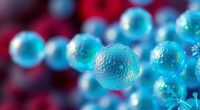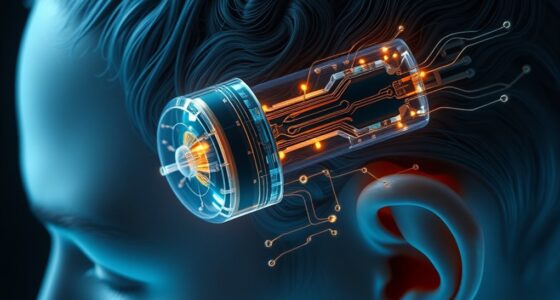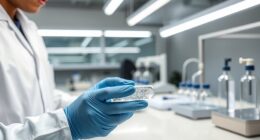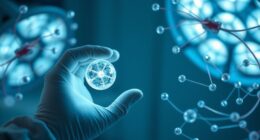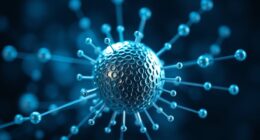Nanomachines in diagnostics allow you to detect diseases early by identifying specific biological markers at the molecular level. They use tiny sensors to recognize proteins, DNA, or other molecules with high sensitivity and speed. These advanced tools help monitor health precisely and minimally invasively, supporting faster diagnosis and better treatment outcomes. As technology advances, they become more accurate and accessible, offering promising possibilities—if you’re curious, you’ll discover how these innovations are shaping future healthcare.
Key Takeaways
- Nanomachines can detect specific biological markers like proteins and DNA fragments with high sensitivity.
- Embedded sensors enable nanomachines to transmit real-time signals for early disease diagnosis.
- Their miniaturization allows for minimally invasive, rapid, and portable diagnostic applications.
- Early detection with nanomachines improves treatment outcomes and reduces healthcare costs.
- Overcoming manufacturing and biocompatibility challenges is essential for their widespread clinical use.
The Science Behind Nanomachines in Healthcare
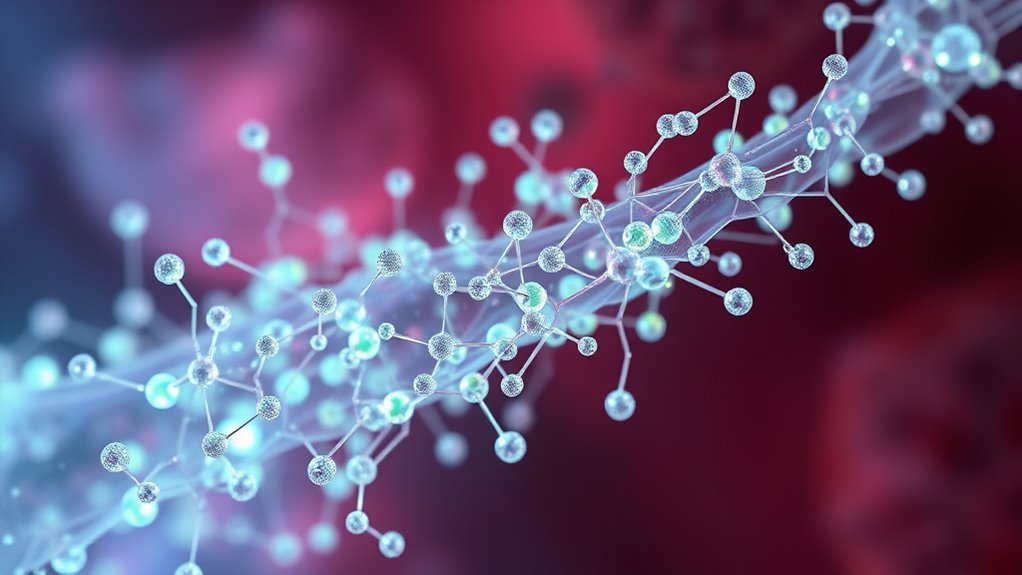
Nanomachines in healthcare operate at a scale so small that they can interact directly with individual cells and molecules. This tiny size allows them to perform precise tasks, like targeting specific pathogens or repairing damaged tissues. Built from advanced materials such as nanorods, nanotubes, or smart polymers, these machines can be engineered to respond to environmental cues. They often contain sensors, actuators, and delivery systems integrated into their structure. Using principles from chemistry, physics, and biology, scientists design nanomachines to navigate the complex biological landscape. They rely on mechanisms like diffusion, molecular recognition, and energy transfer to operate efficiently. This cutting-edge science enables unprecedented control within the body, paving the way for highly targeted diagnostics and treatments. Additionally, understanding the materials used in nanomachines is crucial for improving their safety and functionality in medical applications.
How Nanomachines Detect Biological Markers

Building on their ability to interact with cells and tissues, nanomachines are equipped with highly specialized sensors that can detect biological markers. These sensors recognize specific molecules, such as proteins, DNA fragments, or other indicators of disease. They use various detection mechanisms, including binding affinity, electrical signals, or fluorescence changes, to identify the presence of these markers quickly and accurately. When a nanomachine encounters a biological marker, it responds by transmitting a signal that can be read externally, alerting you to potential health issues. This precise detection allows for early diagnosis of diseases like cancer, infections, or metabolic disorders. By targeting these markers at the molecular level, nanomachines enable highly sensitive and rapid diagnostics, making early intervention more feasible.
Advancements in Nanoscale Diagnostic Technologies

Advancements in nanoscale diagnostic technologies have markedly improved how accurately and sensitively we can detect diseases. These tools deliver rapid, real-time results, making diagnoses faster and more reliable. Plus, their small size allows for portable devices that bring diagnostics directly to your fingertips. Incorporating Mazda Tuning techniques has inspired innovations in miniaturization and precision, further enhancing diagnostic capabilities.
Enhanced Sensitivity and Precision
Thanks to their tiny size and high specificity, nanoscale diagnostic technologies now achieve unprecedented sensitivity and precision. You can detect even trace amounts of biomarkers, enabling early disease identification before symptoms appear. Nanosensors can distinguish between similar molecules, reducing false positives and increasing accuracy. Techniques like quantum dots and nanopores enhance signal detection, making it easier to identify target molecules amidst complex biological samples. This level of diagnostic accuracy allows for personalized diagnostics, tailoring treatments to individual needs. By minimizing interference from surrounding tissues, nanoscale devices improve reliability and consistency in results. As a result, you benefit from early, accurate diagnoses that can markedly impact treatment outcomes, often before traditional methods can detect any abnormalities.
Rapid and Real-Time Results
How quickly you receive diagnostic results can be just as crucial as their accuracy. Advances in nanoscale technologies have enabled nanomachines to analyze samples at unprecedented speeds, providing real-time data. These tiny devices can detect disease markers almost instantaneously, reducing waiting times and allowing immediate decision-making. With nanosensors, you can monitor biological processes continuously, catching early signs of illness before symptoms appear. This real-time monitoring can also help in sauna build and system optimization by providing instant feedback on system performance and safety. The integration of nanomachines into diagnostic systems streamlines workflows, making testing faster and more efficient. As a result, you gain timely insights into your health status, enabling you to act swiftly and appropriately. These advancements are transforming diagnostics into a faster, more responsive tool for early disease detection.
Miniaturization Enables Portability
Have you ever imagined carrying a diagnostic device in your pocket? Thanks to miniaturization, this is now possible. Advances in nanoscale technologies allow you to have portable tools that deliver rapid, accurate results anytime, anywhere. These tiny devices fit easily into your bag or pocket, making health monitoring more convenient than ever. You no longer need bulky lab equipment or visits to specialized clinics for early detection. Instead, you can perform quick tests at home, during travel, or at work. This portability means earlier diagnosis, prompt treatment, and better health management. As nanomachines become more affordable and user-friendly, they’re transforming healthcare from centralized facilities into a personal, on-the-go experience. Miniaturization truly unleashes a new era of accessible, real-time diagnostics. Effective miniaturization enables the integration of multiple functions within a small footprint, enhancing the capabilities of portable diagnostic devices.
Benefits of Early Disease Detection With Nanomachines
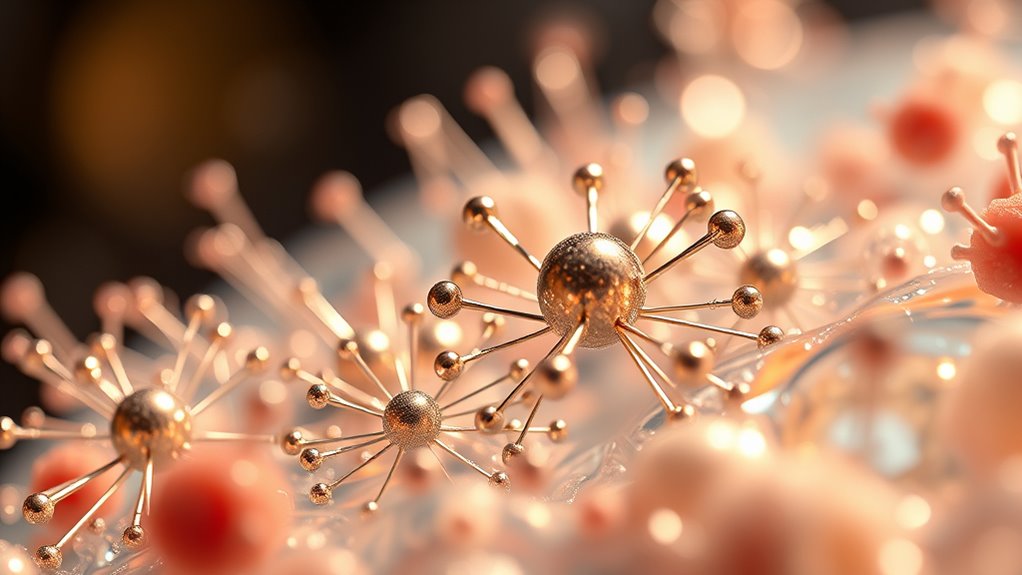
Early detection of diseases through nanomachines offers significant advantages by identifying health issues at their initial stages. This early insight allows you to start treatment sooner, increasing the chances of successful outcomes. Detecting problems early can also reduce the need for invasive procedures and lower healthcare costs. Nanomachines enable highly sensitive and accurate diagnoses, even at the molecular level. They help you monitor disease progression more closely and tailor personalized treatment plans. Additionally, early detection can improve quality of life by preventing severe symptoms and complications. Quotes highlight the profound impact of timely diagnosis and intervention. – Faster diagnosis saves time and reduces stress – Less invasive testing minimizes discomfort – Personalized medicine leads to better results – Cost-effective solutions lower medical expenses – Improved patient outcomes and longevity
Challenges and Future Perspectives in Nano-Diagnostics
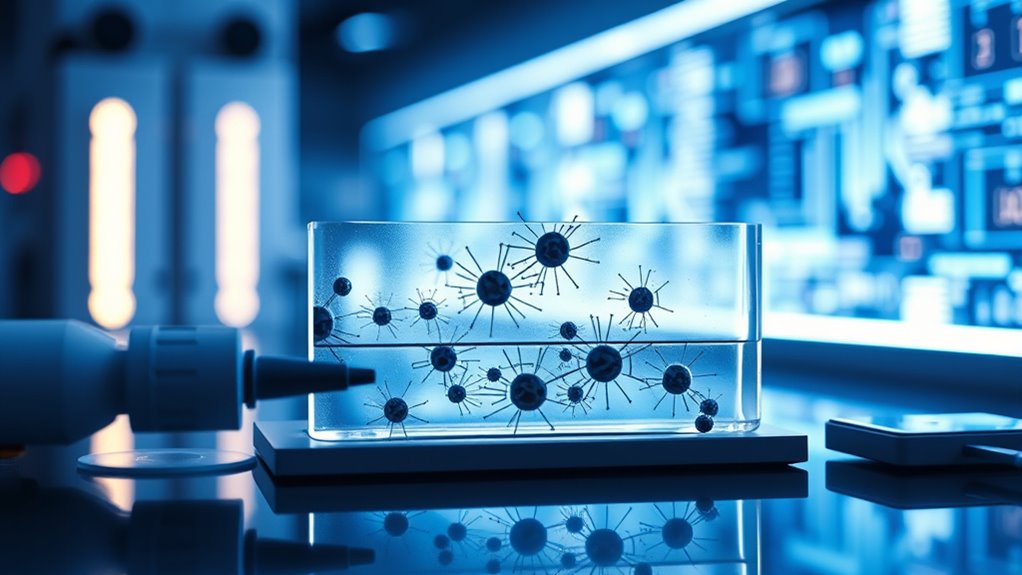
While nanomachines offer promising benefits in diagnostics, several challenges still stand in the way of widespread adoption. You’ll need to address issues related to manufacturing consistency, as producing reliable and uniform nanodevices remains complex. Biocompatibility is another concern; ensuring nanomachines don’t cause adverse immune responses or toxicity is crucial for safety. Additionally, integrating nanomachines into existing healthcare systems requires overcoming regulatory hurdles and establishing standardized protocols. Cost-effective production is essential to make these technologies accessible. Looking ahead, future perspectives include developing smarter, more adaptable nanomachines that can operate effectively within the body’s dynamic environment. Vibrational alignment and overcoming these challenges will be essential to fully realize the potential of nano-diagnostics and revolutionize early disease detection worldwide.
Real-World Applications and Case Studies
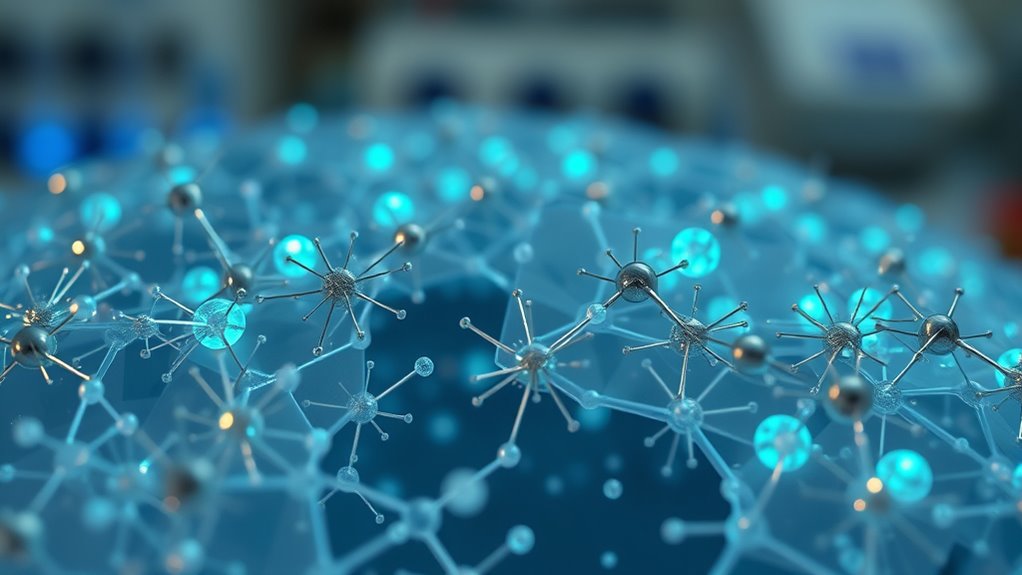
Nanomachines are increasingly being integrated into real-world diagnostic settings, demonstrating their potential to enhance disease detection and monitoring. These tiny devices are already making an impact in hospitals and research labs. For example, nanomachines are used to identify cancer biomarkers at very early stages, allowing for quicker intervention. They also help detect infectious agents like bacteria and viruses with high specificity. In one case study, nanomachines improved the accuracy of blood tests, reducing false positives. Additionally, they enable real-time monitoring of drug delivery and tissue responses. Some notable applications include:
Nanomachines enhance disease detection, enabling early diagnosis, real-time monitoring, and personalized treatment in healthcare.
- Early cancer detection through targeted biomarker analysis
- Rapid identification of infectious diseases
- Enhanced imaging techniques for precise diagnosis
- Monitoring of treatment progress
- Development of personalized medicine approaches
A key aspect of their effectiveness lies in accurate diagnostic methods, which ensures that nanomachines can reliably detect disease markers at the molecular level.
Frequently Asked Questions
How Do Nanomachines Differentiate Between Similar Biological Markers?
You leverage the unique molecular structures and surface markers of biological molecules to differentiate between similar markers. Nanomachines are engineered with specific binding sites, like antibodies or aptamers, that recognize subtle differences in shape or charge. When they encounter a target, they bind precisely, triggering a detectable signal. This high specificity allows you to distinguish even closely related markers, ensuring accurate early disease detection.
What Are the Potential Risks or Side Effects of Using Nanomachines?
You might worry about nanomachines causing unintended damage or triggering immune responses. There’s also a risk they could accumulate in the body, leading to toxicity or interference with normal cell functions. Additionally, if not carefully controlled, they might malfunction or produce unexpected side effects. Researchers are working hard to minimize these risks, but it is crucial to stay aware of potential safety concerns as nanotechnology advances in diagnostics.
How Cost-Effective Are Nanomachine-Based Diagnostic Tools Compared to Traditional Methods?
Imagine a future where tiny detectives save your health—nanomachine diagnostics can be more cost-effective than traditional methods. They often require less invasive procedures, reduce hospital stays, and provide quicker results, cutting overall costs. While initial investments might be high, their precision and early detection capabilities can save money long-term by preventing advanced disease treatments. So, these miniature marvels could be a smart, economical choice for your healthcare needs.
Can Nanomachines Be Designed to Target Multiple Diseases Simultaneously?
Yes, nanomachines can be designed to target multiple diseases simultaneously. You can engineer them with various sensors and binding agents that recognize different biomarkers, allowing for multiplexed detection. By customizing their surface properties, you enable nanomachines to identify multiple pathogens or disease markers at once, improving diagnostic efficiency. This approach helps you get all-encompassing results quickly, making early detection more accessible and accurate across diverse medical conditions.
What Regulatory Challenges Exist for Clinical Implementation of Nanomachine Diagnostics?
You face a complex regulatory landscape when implementing nanomachine diagnostics clinically. Agencies demand rigorous safety and efficacy data, but the tiny scale and novel mechanisms of nanomachines challenge existing standards. Steering approval processes can be unpredictable, with potential delays and uncertainties. Staying ahead requires proactive engagement with regulators, thorough testing, and transparent communication. The stakes are high, and the path to approval demands innovation not just in technology but also in compliance.
Conclusion
By harnessing nanomachines, you access faster detection, more accurate diagnosis, and earlier intervention. These tiny devices revolutionize healthcare by empowering you to catch diseases before symptoms appear. They offer precision, efficiency, and hope, transforming medicine’s future. As nanotechnology advances, you’ll experience smarter, more personalized care. Embrace these innovations, and join the journey toward healthier lives, where early detection becomes your strongest weapon, and nanomachines pave the way for a brighter, healthier tomorrow.

